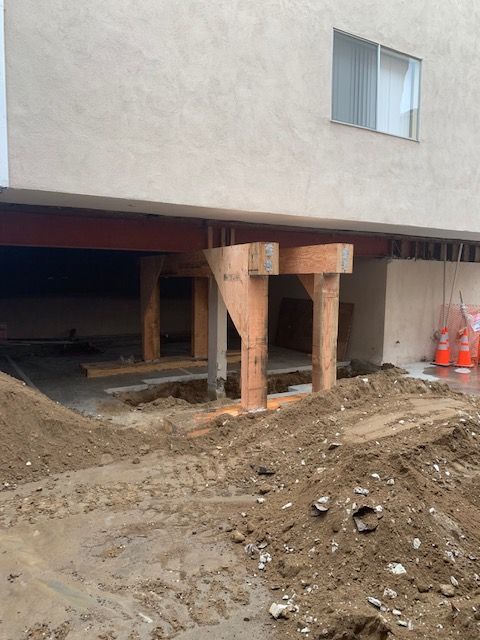Most property owners in Los Angeles are well aware of the Soft-Story Retrofit program by now. The program was rolled out in 2015 when the city passed two new ordinances to make buildings and structures around the city safer during an earthquake. Longtime residents will remember the Northridge Earthquake of 1994 which caused millions of damage to property and killed 60 people. LA officials decided they did not want this to happen again.
A little over 25 years later and advancements in technology and construction are making city structures safer for everyone. Retrofitting soft-story buildings is a construction field that has exploded over the last four years since the city has mandated that over 15,000 buildings are in need of reinforcing. But many of these new companies are not looking at the big picture. So many of their retrofit designs are flawed since they only focus on adding steel columns and very few are doing anything to the existing wood-frame.
Understanding the Basics of Physics
Soft-story retrofitting is a whole new industry and we are all having to learn as we go. The best way to start is with a basic understanding of physics. The first principle of physics states that a hypothesis has to form from the foundation of known truths. From there we can use this hypothesis to create the methods needed for a successful soft-story retrofit.
Based on this idea the first place to start is by examining the current condition of the existing wood frame. Without knowing what this is, there is no way to know how much more lumber is needed to property transfer seismic forces to the newly installed steel components. While it makes sense to just install reinforced steel columns and shear walls to strengthen a building, these won’t prevent damage to the building during an earthquake if the wood frame is decayed or weakened.
One Common Mistake Many People Make
The most common mistake made in about 90% of retrofit projects is not removing the stucco before construction begins. Simply peeling back the stucco in critical connection areas would allow contractors and engineers to assess the condition of the existing wood frame. In many older apartment complexes, the wood frame and sub floors have been exposed to water leaks causing them to decay. Additional lumber is needed to create load paths to properly transfer the forces of an earthquake to a newly installed moment frame.
The current building codes only require that the minimum be done to prevent loss of life. However, the minimum amount of reinforcement required by the city is not enough to prevent the building from being damaged. Even though it may still be standing after an earthquake, it may not be livable for your tenants. The entire structure needs to be reinforced including the joists, frame and the connections to the foundation.
Adding New Connections
A complete retrofit design needs to include the reinforcement of the wood frame that is already in place. One way to accomplish this is to add new connections, such as Simpson Strong-Tie LTP4/LTP5 and A34/A35 plates. This step helps to create a sturdy structure that transfers earthquake loads evenly and ensures the building will remain standing in the event of a major seismic event.
The first step is to remove the stucco covering the frame. This allows the contractor to assess the weak areas. We like to use a combination of wood boards to create a block and installing more steel connectors like Simpson Strong-Tie LTP 4 connectors over the new blocking. This provides a design that allows the subfloor to resist torsion and ties it to the existing dragline beam.
Building Systems that Work Together
By installing wood blocking above a steel moment frame, we create a solid connection. This provides a transfer of the earthquake’s forces between the new frame and the existing building. After that, we run the wood blocking through the length of the structures. Now we have made more connections between the new and old structures which lets them work together. By creating a larger blocking frame it is more likely that the shaking of an earthquake will transfer smoothly back to the steel moment frame. Our team of specialists put a lot of thought and detail into crafting our retrofit designs. They work to ensure the soft-story retrofit will not just be strong enough but also smart enough to protect your building.
Hire a Seismic Professional
If you have never felt an earthquake before consider yourself lucky. Longtime residents of Southern California will tell you an earthquake is a violent force of nature. With so many new contractors and companies offering soft-story retrofits these days, it is extremely important that you hire one qualified for the job. Here at Retrofitting 360, we take our job very seriously. Over 250,000 residents could be at risk of serious injury in the event of a major earthquake. We understand that it is our duty and responsibility to use our vast knowledge of soft-story buildings to deliver a project that is high in quality and performance.
What we offer
Over 13,000 buildings around Los Angeles are on the city’s list of soft-story buildings that need to be retrofitted. Owners were issued letters to comply and given a deadline for when the work needs to be completed. Our Los Angeles retrofit contractors can help you get started with a consultation. One of our specialized contractors will walk through your property to assess the conditions and determine what modifications it will need. We will then provide you with a detailed report that includes the work to be done to bring your building up to the city’s ordinances.
RetroFitting 360, Inc. employees are licensed, insured and bonded general contractors and our management team consists of industry professionals with years of experience in the construction and seismic engineering fields. We will work with you throughout the process to make your soft-story retrofit as painless as possible. Whether you received a notice to comply with the retrofit program, or you are just worried about your building’s foundation and have questions about the process, you can contact us to schedule a free evaluation of your property and find out more about our cost-effective solutions.


